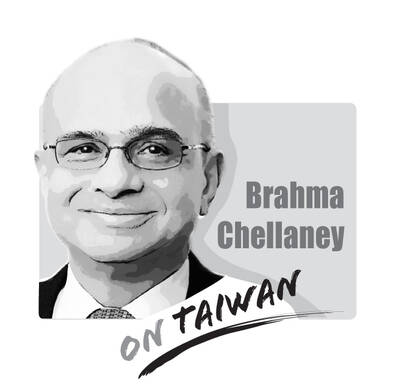It is always encouraging to see members of the international community pay attention to Taiwan, whose travails as it navigates the rough seas of its relations with China are often conveniently ignored for the sake of “larger” considerations.
Given the potential ramifications of tomorrow’s presidential elections for regional security and Taipei’s relations with Beijing, it is unsurprising that an army of foreign reporters and academics would be parachuted into Taiwan to observe its rambunctious democracy at work.
Equally welcome is the arrival of international observers who have been invited by local organizations to monitor the elections to ensure that the process is fair and does justice to the sacrifices made by previous generations of Taiwanese who, for decades, did not have the privilege of selecting their leader.
In a highly charged campaign marked by scandals — from the possible falsification of evidence used in allegations against Democratic Progressive Party (DPP) presidential candidate Tsai Ing-wen (蔡英文) to claims that intelligence agencies engaged in illegal surveillance against her — the presence of neutral electoral monitors from abroad could provide a much-needed dose of sobriety to the whole affair. Or it should have.
The problem is that the organizations behind the invitations extended to the international monitors have at times appeared more interested in underscoring which candidate they hope will win rather than making sure that the electoral process remains transparent and is not tampered with.
One could argue that such an outcome was inevitable, a consequence of the vast resource disparity that exists between the two principal political parties involved in the elections. Despite claims to the contrary, President Ma Ying-jeou’s (馬英九) Chinese Nationalist Party (KMT) remains one of the wealthiest political entities in the world, turning Tsai into a bit of a David against the KMT Goliath, an imbalance that has only been exacerbated by the overt support given the KMT by Beijing, big business, institutional investors and even some elements within the White House.
As a result, whether it was intended or not, the International Committee for Fair Elections in Taiwan (ICFET), which counts the likes of DPP legislator Chai Trong-rong (蔡同榮) as its executive chairman, has come across as pretty green.
Not to be bested, the pan-blue side recently announced that it had invited its own international monitors, a group that includes former American Institute in Taiwan director Douglas Paal.
Anyone who accuses the minds behind the ICFET of being too green and therefore partial should look at the political affiliations of the Cross-Strait Interflow Prospect Foundation, the think tank that invited Paal and others to come to Taiwan to observe the elections. Its chairman, Louis Tzen (鄭文華), is closely affiliated with the KMT’s in-house think tank, the National Policy Foundation.
Unfortunately for the majority of international monitors who did come to Taiwan as impartial observers, the politicization of the groups risks undermining their credibility. This, in turn, could make it more difficult for their findings to be taken seriously and could give rise to accusations that they are taking sides in the election — especially if serious irregularities were to be uncovered by the observer groups.
Whether they knew it or not, international observers have been sucked into the vortex of green-blue politics in Taiwan. Through no fault of theirs, they arrive here facing a credibility handicap, victims of a political system whose impartiality is oftentimes observed in the breach.

Taiwan stands at the epicenter of a seismic shift that will determine the Indo-Pacific’s future security architecture. Whether deterrence prevails or collapses will reverberate far beyond the Taiwan Strait, fundamentally reshaping global power dynamics. The stakes could not be higher. Today, Taipei confronts an unprecedented convergence of threats from an increasingly muscular China that has intensified its multidimensional pressure campaign. Beijing’s strategy is comprehensive: military intimidation, diplomatic isolation, economic coercion, and sophisticated influence operations designed to fracture Taiwan’s democratic society from within. This challenge is magnified by Taiwan’s internal political divisions, which extend to fundamental questions about the island’s identity and future
The narrative surrounding Indian Prime Minister Narendra Modi’s attendance at last week’s Shanghai Cooperation Organization (SCO) summit — where he held hands with Russian President Vladimir Putin and chatted amiably with Chinese President Xi Jinping (習近平) — was widely framed as a signal of Modi distancing himself from the US and edging closer to regional autocrats. It was depicted as Modi reacting to the levying of high US tariffs, burying the hatchet over border disputes with China, and heralding less engagement with the Quadrilateral Security dialogue (Quad) composed of the US, India, Japan and Australia. With Modi in China for the
The Chinese Nationalist Party (KMT) has postponed its chairperson candidate registration for two weeks, and so far, nine people have announced their intention to run for chairperson, the most on record, with more expected to announce their campaign in the final days. On the evening of Aug. 23, shortly after seven KMT lawmakers survived recall votes, KMT Chairman Eric Chu (朱立倫) announced he would step down and urged Taichung Mayor Lu Shiow-yen (盧秀燕) to step in and lead the party back to power. Lu immediately ruled herself out the following day, leaving the subject in question. In the days that followed, several
The Jamestown Foundation last week published an article exposing Beijing’s oil rigs and other potential dual-use platforms in waters near Pratas Island (Dongsha Island, 東沙島). China’s activities there resembled what they did in the East China Sea, inside the exclusive economic zones of Japan and South Korea, as well as with other South China Sea claimants. However, the most surprising element of the report was that the authors’ government contacts and Jamestown’s own evinced little awareness of China’s activities. That Beijing’s testing of Taiwanese (and its allies) situational awareness seemingly went unnoticed strongly suggests the need for more intelligence. Taiwan’s naval